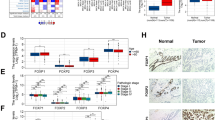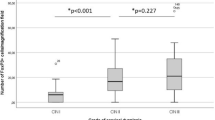Abstract
Purpose
To explore the expression of forkhead/winged helix transcription factor p3(Foxp3) and toll-like receptor 4(TLR4) in cervical cancer and evaluate their clinical significance.
Methods
Foxp3 and TLR4 protein expression was detected in 105 cervical tissue specimens including cervical cancer, cervical intraepithelial neoplasia (CIN), and healthy control samples using immunohistochemistry. Their relationship with clinicopathologic parameters was also determined.
Results
Foxp3 and TLR4 had high levels of expression in cervical cancer cells (91.43 and 82.86%, respectively). Foxp3 levels were significantly associated with FIGO stage (P < 0.001) and tumor size (P = 0.034), while TLR4 levels were associated with clinical FIGO stage (P = 0.033) and lymph node metastasis (P = 0.031). Their expression levels were not correlated with age, histologic type, or differentiation (all P > 0.05). These findings suggest that Foxp3 and TLR4 may be useful prognostic indicators of cervical carcinoma. In addition, there were significant positive relationships between Foxp3 and TLR4 expression (r = 0.703, P < 0.001), which shows a possible link and synergistic role of Foxp3 and TLR4 in promoting the immune escape of cervical cancer.
Conclusions
Foxp3 and TLR4 may be useful biomarkers for patient prognosis and cervical cancer prediction and treatment.


Similar content being viewed by others
References
Singh M, Tyagi S, Bhui K, Prasad S, Shukla Y (2010) Regulation of cell growth through cell cycle arrest and apoptosis in HPV 16 positive human cervical cancer cells by tea polyphenols. Invest New Drugs 28(3):216–224. doi:10.1007/s10637-009-9240-x
da Luz Moreira A, Mor I, Geisler DP, Remzi FH, Kiran RP (2011) Laparoscopic resection for rectal cancer: a case-matched study. Surg Endosc 25(1):278–283. doi:10.1007/s00464-010-1174-z
Wilczynski JR, Radwan M, Kalinka J (2008) The characterization and role of regulatory T cells in immune reactions. Front Biosci J Virtual Library 13:2266–2274
Fontenot JD, Rasmussen JP, Williams LM, Dooley JL, Farr AG, Rudensky AY (2005) Regulatory T cell lineage specification by the forkhead transcription factor foxp3. Immunity 22(3):329–341. doi:10.1016/j.immuni.2005.01.016
Hori S, Nomura T, Sakaguchi S (2003) Control of regulatory T cell development by the transcription factor Foxp3. Sci (New York, NY) 299(5609):1057–1061. doi:10.1126/science.1079490
Karanikas V, Speletas M, Zamanakou M, Kalala F, Loules G, Kerenidi T, Barda AK, Gourgoulianis KI, Germenis AE (2008) Foxp3 expression in human cancer cells. J Trans Med 6:19. doi:10.1186/1479-5876-6-19
Cunha LL, Morari EC, Nonogaki S, Soares FA, Vassallo J, Ward LS (2012) Foxp3 expression is associated with aggressiveness in differentiated thyroid carcinomas. Clinics (Sao Paulo, Brazil) 67(5):483–488
Weller P, Bankfalvi A, Gu X, Dominas N, Lehnerdt GF, Zeidler R, Lang S, Brandau S, Dumitru CA (2014) The role of tumour FoxP3 as prognostic marker in different subtypes of head and neck cancer. Euro J Cancer 50(7):1291–1300. doi:10.1016/j.ejca.2014.02.016 (Oxford, England: 1990)
Wang LH, Su L, Wang JT (2010) Correlation between elevated FOXP3 expression and increased lymph node metastasis of gastric cancer. Chin Med J 123(24):3545–3549
Ohara M, Yamaguchi Y, Matsuura K, Murakami S, Arihiro K, Okada M (2009) Possible involvement of regulatory T cells in tumor onset and progression in primary breast cancer. Cancer Immunol Immunotherapy: CII 58(3):441–447. doi:10.1007/s00262-008-0570-x
Stanilov N, Miteva L, Mintchev N, Stanilova S (2009) High expression of Foxp 3, IL-23p19 and survivin mRNA in colorectal carcinoma. Int J Colorectal Dis 24(2):151–157. doi:10.1007/s00384-008-0588-8
Zuo T, Liu R, Zhang H, Chang X, Liu Y, Wang L, Zheng P, Liu Y (2007) FOXP3 is a novel transcriptional repressor for the breast cancer oncogene SKP2. J Clin Investig 117(12):3765–3773. doi:10.1172/jci32538
Zhang YB, He FL, Fang M, Hua TF, Hu BD, Zhang ZH, Cao Q, Liu RY (2009) Increased expression of Toll-like receptors 4 and 9 in human lung cancer. Mol Biol Rep 36(6):1475–1481. doi:10.1007/s11033-008-9338-9
Petricevic B, Vrbanec D, Jakic-Razumovic J, Brcic I, Rabic D, Badovinac T, Ozimec E, Bali V (2012) Expression of Toll-like receptor 4 and beta 1 integrin in breast cancer. Med Oncol (Northwood, London, England) 29(2):486–494. doi:10.1007/s12032-011-9885-0
Dang S, Peng Y, Ye L, Wang Y, Qian Z, Chen Y, Wang X, Lin Y, Zhang X, Sun X, Wu Q, Cheng Y, Nie H, Jin M, Xu H (2013) Stimulation of TLR4 by LMW-HA induces metastasis in human papillary thyroid carcinoma through CXCR7. Clinical Dev Immunol 2013:712561. doi:10.1155/2013/712561
Hagstrom J, Heikkila A, Siironen P, Louhimo J, Heiskanen I, Maenpaa H, Arola J, Haglund C (2012) TLR-4 expression and decrease in chronic inflammation: indicators of aggressive follicular thyroid carcinoma. J Clin Pathol 65(4):333–338. doi:10.1136/jclinpath-2011-200402
Wang Y, Weng Y, Shi Y, Xia X, Wang S, Duan H (2014) Expression and functional analysis of Toll-like receptor 4 in human cervical carcinoma. J Membrane Biol 247(7):591–599. doi:10.1007/s00232-014-9675-7
Goto Y, Arigami T, Kitago M, Nguyen SL, Narita N, Ferrone S, Morton DL, Irie RF, Hoon DS (2008) Activation of Toll-like receptors 2, 3, and 4 on human melanoma cells induces inflammatory factors. Mol Cancer Ther 7(11):3642–3653. doi:10.1158/1535-7163.mct-08-0582
He W, Liu Q, Wang L, Chen W, Li N, Cao X (2007) TLR4 signaling promotes immune escape of human lung cancer cells by inducing immunosuppressive cytokines and apoptosis resistance. Mol Immunol 44(11):2850–2859. doi:10.1016/j.molimm.2007.01.022
Milkova L, Voelcker V, Forstreuter I, Sack U, Anderegg U, Simon JC, Maier-Simon C (2010) The NF-kappaB signalling pathway is involved in the LPS/IL-2-induced upregulation of FoxP3 expression in human CD4+ CD25 high regulatory T cells. Exp Dermatol 19(1):29–37. doi:10.1111/j.1600-0625.2009.00953.x
Caramalho I, Lopes-Carvalho T, Ostler D, Zelenay S, Haury M, Demengeot J (2003) Regulatory T cells selectively express toll-like receptors and are activated by lipopolysaccharide. J Exp Med 197(4):403–411
Rothschild SI, Thommen DS, Moersig W, Muller P, Zippelius A (2015) Cancer immunology—development of novel anti-cancer therapies. Swiss Med Weekly 145:w14066. doi:10.4414/smw.2015.14066
Gilboa E (2004) The promise of cancer vaccines. Nat Rev Cancer 4(5):401–411. doi:10.1038/nrc1359
Zou W (2005) Immunosuppressive networks in the tumour environment and their therapeutic relevance. Nat Rev Cancer 5(4):263–274. doi:10.1038/nrc1586
Feuerer M, Hill JA, Mathis D, Benoist C (2009) Foxp3 + regulatory T cells: differentiation, specification, subphenotypes. Nat Immunol 10(7):689–695. doi:10.1038/ni.1760
Koh KP, Sundrud MS, Rao A (2009) Domain requirements and sequence specificity of DNA binding for the forkhead transcription factor FOXP3. PLoS One 4(12):e8109. doi:10.1371/journal.pone.0008109
Klages K, Mayer CT, Lahl K, Loddenkemper C, Teng MW, Ngiow SF, Smyth MJ, Hamann A, Huehn J, Sparwasser T (2010) Selective depletion of Foxp3+ regulatory T cells improves effective therapeutic vaccination against established melanoma. Cancer Res 70(20):7788–7799. doi:10.1158/0008-5472.can-10-1736
Khalil J, El Kacemi H, Afif M, Kebdani T, Benjaafar N (2015) Five years’ experience treating locally advanced cervical cancer with concurrent chemoradiotherapy: results from a single institution. Arch Gynecol Obstet 292(5):1091–1099. doi:10.1007/s00404-015-3712-3
Kawai T, Akira S (2010) The role of pattern-recognition receptors in innate immunity: update on Toll-like receptors. Nat Immunol 11(5):373–384. doi:10.1038/ni.1863
Medzhitov R, Preston-Hurlburt P, Janeway CA Jr (1997) A human homologue of the Drosophila Toll protein signals activation of adaptive immunity. Nature 388(6640):394–397. doi:10.1038/41131
Huang B, Zhao J, Unkeless JC, Feng ZH, Xiong H (2008) TLR signaling by tumor and immune cells: a double-edged sword. Oncogene 27(2):218–224. doi:10.1038/sj.onc.1210904
Acknowledgements
This study was supported by the National Nature Science Foundation of China (Grant No. 81372776), and the Free Researcher Project of Shengjing Hospital (Grant No. 201302).
Author information
Authors and Affiliations
Corresponding author
Ethics declarations
Ethical approval
The study received ethical approval from the local Research Ethics Committee, and written consent was obtained at the time of recruitment.
Conflict of interest
The authors declare that they have no conflict of interest.
Rights and permissions
About this article
Cite this article
Zhang, H., Zhang, S. The expression of Foxp3 and TLR4 in cervical cancer: association with immune escape and clinical pathology. Arch Gynecol Obstet 295, 705–712 (2017). https://doi.org/10.1007/s00404-016-4277-5
Received:
Accepted:
Published:
Issue Date:
DOI: https://doi.org/10.1007/s00404-016-4277-5




